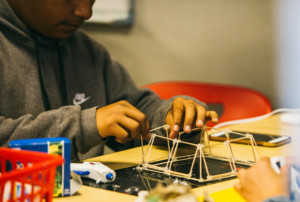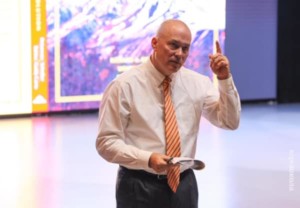10 Lessons in Leading New School Development

We surveyed 20 experts in new school development, and the superintendents and network CEOs said getting the culture right was key to success. In addition to culture, the experts shared 10 leadership lessons for successful new school development:
- Visit Great Schools
- Build and Test Agreements
- Make LX Vision a Reality
- Hire Early, Hire Well
- Stay Flexible, Distribute Leadership
- Build Reputation, Make Friends
- Market Distinctiveness
- Sequence (But Don’t Forget) Innovations
- Listen
- Sharpen the Saw
1. Visit Great Schools
“Visit other schools to learn the details of how others were doing things,” encouraged Ben Daley, CAO at High Tech High. “At this point, there are many, many folks across the country with experience starting schools. Get out of your bubble and talk with others who have done it.”
“When it comes to schools, seeing is believing,” said Brian Greenberg, Silicon Schools. “I’ve found it more effective to take educators to schools where they can see new models in person rather than trying to convince them with only words.”
Visiting 100 schools in seven countries proved transformational for the faculty of Singapore American School (SAS). Their professional learning communities proved to be a critical vehicle for SAS faculty to discuss, synthesize and incorporate observed innovations. A culture of excellence, possibility and care makes SAS an inspiring school worth visiting.
2. Build and Test Agreements
“Have a short and sweet vision and mission that will be easy for your teachers, parents and students to quickly understand” recommended Mike Feinberg. The co-founder of KIPP said the mission should make it easy to reverse engineer back from mission accomplished to how Day 1 needs to go.
“Find ways to prototype your designs before you launch, but be careful not to take on too much in the year immediately prior to launch,” said Scott Benson, NewSchools Venture Fund.
Ron Berger, EL Education, has supported the opening of dozens of project-based schools. He recommends facilitating staff agreements “on as many consistencies as possible before students arrive, so that things feel clear, respectful and safe for all students.” Agreements could include big things like a code of character and small things like cell phone policy or expectations for how adults and students address each other.
“As you design the structures that will support learning experiences for your faculty and students (e.g., faculty retreats, course schedule, advisory structure), keep in mind that form follows function and an essential function of schooling is to provide conditions that foster the creation of deep and meaningful relationships,” said Kelly Wilson, High Tech High Graduate School of Education (see white paper).
3. Market Distinctiveness
Why do we exist? What is our value proposition, or the promise of benefit intended to attract and satisfy the communities we serve? What group of students are most at risk? What do we consider success? How is the education market changing?
With expanding school choice in many cities, these are a few of the questions Dwight Jones suggests school leaders ask. Jones is superintendent in residence with Discovery Education and former Clark County (Las Vegas) superintendent and chief in Colorado.
When the leaderships team is clear about the distinctive value proposition of the new school, they can communicate it to stakeholder groups. If a school opens by adding a grade a year, you have several years to refine the mission and communicate your value proposition.
“Charters and schools of choice must distinguish themselves in the marketplace by not only being better than their competition, but being different,” said Jon Hage, Charter Schools USA. “We can drive results faster when we embrace our unique autonomy by being platforms of innovation that make us learning labs that benefit students.”
4. Make Learner Experience Vision a Reality
Pat DeKlotz, Kettle Moraine School District, said, “Make sure you understand the student experience within the school. Too often schools are defined around the adults and what they perceive to be best for students. Take the opportunity to spend a day shadowing a student. Experience the school for yourself. It is not always what you anticipate.”
DeKlotz’s metro Milwaukee district opened three small thematic flex academies as in-district charter schools housed inside a large comprehensive high school. Each started with two teachers and an idea. They now serve almost 40% of the students and provide in-school field trip opportunity for teachers. (KM Perform, a performing arts academy, is pictured below.)

“Given the need to spend a lot of time on instruction as well, give yourself room for this by having more instructional time during the day, week and year,” said Feinberg.
Opening a new school is about bringing vision and theory to reality and practice, said Danny Medved, principal of Denver School of Innovation & Sustainable Design, a new school incubated by DPS Imaginarium and supported by a Carnegie grant.
“Have a clear and concise vision that you can map all elements of your program back to and that you can message to all stakeholders in a compelling way,” said Medved who said a strong year one would:
- Establish a school-wide culture of ownership of learning among students, staff, leaders and parents;
- Establish a clear and coherent instructional model; and
- Deliver on and execute vision and school specific learning experiences that set the program apart: job shadows, student led conferences, college visits, intensive experiential learning excursions, two or three high-impact cross-content projects and end-of-year demonstrations of learning.

“If you’re opening a personalized learning school, none of your students have experienced this kind of responsibility for even a moment of their previous years in school,” said Andy Calkins, whose Next Generation Learning Challenges (NGLC) has sponsored 100 new schools through national and regional grant programs. “In most new schools, NGLC has found a third of students will gravitate quickly towards it; a third will get there within a semester of good scaffolding; a third may take quite a bit longer than that. Be ready.”
“We thought we had built the perfect model for a school–and then the kids showed up.” Calkins said this is a common reaction of NGLC grantees.
Key to creating the desired LX is to create great TX–teacher experience. “When working with teachers, model the instructional practices you want to see in the classroom with students,” said Daley. “Lecturing about the importance of student-centered teaching practices is not likely to work.”
5. Hire Early, Hire Well
Terry Grier, former Houston ISD superintendent, recommended “hiring quality teacher as early as possible.”
In addition to a lot of new schools and facilities modernization, Grier said, “The most important building that has been going on in HISD’s ecosystem is in developing our human capital. We know that our 21st century campuses are only as good as the principals who lead them and the teachers who create magic in each classroom.” For that reason, Grier’s team enacted bold initiatives to hire and retain the most effective educators possible.
“Hire right the first time!” said Nicole Assisi, Thrive Public Schools. “There is no such thing as spending too much time on hiring.” Dr. Assisi has helped open five leading southern California schools. (See feature on Thrive)
 The Thrive hiring process includes demonstration lessons. Glenn Jacobson flew in from Chicago and demonstrated a lesson with manipulatives (like the one he’s using in a rotational blend, pictured right). He was in a Master’s program for using tech in innovative ways and was sick of working in schools that didn’t do what he was learning.
The Thrive hiring process includes demonstration lessons. Glenn Jacobson flew in from Chicago and demonstrated a lesson with manipulatives (like the one he’s using in a rotational blend, pictured right). He was in a Master’s program for using tech in innovative ways and was sick of working in schools that didn’t do what he was learning.
Medved thinks it key to “find highly skilled teachers who are bought into the vision, have the skills to work in the instructional model, and a growth mindset.”
“During the opening phase schools, staff tend to be smaller and inexperienced teachers are more likely to be hired,” warned Joan Massey, Chavez Schools. She recommended “working toward a balance of staff who have at least three-year experience to support the onboarding of new teachers and the success of the academic program and instruction.”
Grier thinks it is most productive to “focus on teacher’s strengths rather than weaknesses.” For example, if a third grade teacher gets great math results and poor reading results, schedule them to just teach math. Don’t waste time and money trying to make them a better reading teacher.
6. Stay Flexible, Distribute Leadership
“Without the right people I would not have considered opening another school,” said Alex Magana, Beacon Network Schools. After a successful turnaround in a Denver middle school (see feature) Magana is building a turnaround network where many of his teachers “step into leadership roles and influence others.”
“Distribute leadership within schools by identify superstars and putting them in school leadership positions,” recommended Grier. Leadership roles could include multi-classroom leaders, subject chairs, new teacher mentors and project managers.
“When your initial plan breaks down it does not mean you should alter the endgame you and your team set out to enact. It does, however, mean that you will have to find a new way to get there,” said Jim May, Chief Schools Officer at New Tech Network. Sometimes, the hardest part of that is letting go of the plan you had already made. “Be fanatically committed to the vision you set forth as a school community and endlessly flexible about what it might look like to get there,” adds May.
“Plan how you will use your day, prepare for interruptions, plan how you will deal with those interruptions and share this with your team,” said Aaron Brenner, 1 World Network of Schools, a nonprofit KIPP spinout supporting 16 global schools (including one in Israel, below).

“Be fanatical about the end, and endlessly flexible about what it might look like to get there,” said May. “Starting a new school is an immensely daunting challenge. Among the most daunting things is that it almost certainly will not go according to plan.”
7. Build Reputation, Make Friends
“Ask teachers to identify three things they like about working in their school and district, and to share those three things with 10 people prior to the beginning of the school year,” suggested Grier. He thinks word of mouth advertising boosts brand recognition and reputation. They can ask their students to do the same thing once school starts
Assisi notes that whether you are starting a charter, converting a school or working with your district to launch a new program, the work will be highly political and politicized. “Change can be hard for folks and you will want to make sure you have some strong community allies.”
To mitigate likely vocal critics, Assisi suggests finding a way to capture and share signs of support through community meetings, petitions, letters of support or press conferences.
“If you are launching a school that is fundamentally different from traditional school models, your students and their parents will need triple the amount of scaffolding and educating that you think they will, about how your school will operate and why,” said Calkins. His 100 grantees universally say they badly underestimated the amount of outreach they needed to do to parents.
8. Sequence (But Don’t Forget) Innovations
“Rationalize and/or sequence the innovation(s) you are pursuing,” said Benson. “Trying to innovate on multiple dimensions while also trying to launch a school will significantly increase the degree of difficulty.”
 Principal Magaña (right) phased in three core strategies at Grant Beacon Middle School–blended learning, extended learning opportunities and character development–over three years. Each phase was well designed, well communicated and well supported, allowing his staff to master a set of shared protocols before adding a new phase of work.
Principal Magaña (right) phased in three core strategies at Grant Beacon Middle School–blended learning, extended learning opportunities and character development–over three years. Each phase was well designed, well communicated and well supported, allowing his staff to master a set of shared protocols before adding a new phase of work.
“Identify the processes your school will use to manage innovation,” encouraged Alex Hernandez of the Charter School Growth Fund, which has supported networks with 500 high performing schools. “The most innovative schools succeed because they consistently improve their 1.0 school models.” The iteration process, adds Hernandez, includes looking at data, reviewing processes and making changes. “It’s easy for innovation to stop once the kids show up because the team gets overwhelmed with the demands of running a school.”
Head of strategy for Denver Public Schools Peter Piccolo agreed. “Plan your continuous improvement loop now. If this loop is not clear before the first day of school, it’s tougher to put one in place once the doors open for business.” (Read more about innovation in Denver.)
“Start small and don’t build everything at the same time,” said Massey. “When working to be innovative and think differently about teaching and learning it is important to target three high leverage strategies per year. This allows for clarity from all stakeholders and a better way to monitor and adjust throughout the year.”
“It’s also not about having the best ideas,” added Hernandez. “It’s about executing consistently. The only things that matter are the experiences you can actually put in front of students.”
9. Listen
“Always be open to feedback and create opportunities when you actively solicit feedback,” said DeKlotz. “Don’t expect it to come to you, seek it out. And once you have received it, act on it. Reflect and communicate back what you have heard and how you will use the information. People will quit talking if you quit listening.”
The Wisconsin superintendent of the year added, “Everyone start out wanting success. What success looks like can differ from one individual to another, but when people are valued for their input, their definition of success broadens to include elements of the organization beyond themselves.”
10. Sharpen the Saw
“Get away from everything in the middle of the ninety day countdown,” recommended Brenner. “It will give you the space to breathe again, to reflect on what is needed to do in the final forty days before launch, and the renewed strength to do it.”
“Remember to give yourself space to learn from what you are doing and to ‘retool’ when necessary,” said DeKlotz. “You have to become comfortable with learning from your experience, and that includes when you don’t get it right the first time.
Calkins recommends mindfulness. “Remember to breathe.”
For more, see:
- The Micro-School Opportunity
- Get the Culture Right: The Most Important New School Factor
- 10 Lessons in Leading New School Development







Tom Vander Ark
Good addition from @JoeCFeldman:
As someone who has started charter schools, and authorized others to start schools, what is starkly absent from this list is "working alongside the existing community". Schools should not be helicoptered in, but should respect and build bridges with the people, institutions, and history in neighborhoods they seek to serve.
Rogier Gregoire Ed.D. GHSE '72 curriculum and Supervision.
The essential problem facing American education is the model designed and built to serve industrial capitalism. It is in both form and function an instrument desined to serve vocational objectives by conditioning students to the demands of an Industrial society. Scshool ought to serve human development not simply workforce bias.
In order to tranform current school policies and practices to accomodate the demands of human development everey decision involving the current practice must be resolved in favor of human potential so that the essential humanity of those involved is served and protected. What we are looking for is an epistomology that has been examined by a process of critical thought, that is,, to reveal and evaluate the assumptions that underlie the practice. This would require abandoning didactic pedagogies in favor of dialogic instructional models that afford the student and the instructor/facilitator (teacher) every opportunity for intellectual autonomy and inquiry. Look for tranforamtion not change as the purppose of the effort.
Replies
Tom Vander Ark
Thanks Roger. I appreciate your comment. This #NewSchools series focused on the task of opening schools rather than school design.
On the subject of aims and means, I recently addressed the positive trend toward embracing broader aims and more student-centered pedagogies and suggested that the vision for a learning environment should answer two key questions:
-Aims: What should young people know and be able to do?
-LX: What powerful learning experiences will help develop the desired knowledge, skills and dispositions?
http://www.gettingsmart.com/gettingsmart-staging/2016/03/look-shared-vision-powerful-learning/
Shabnam Haseeb
Totally agreed with your point of view being a Principal of a boarding school. Even it is in practice